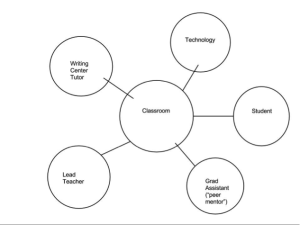Bourelle, Tiffany, Sherry Rankins-Robertson, Andrew Bourelle, and Duane Roen. “Assessing Learning in Redesigned Online First-Year Composition Courses.” Digital Writing Assessment and Evaluation. Eds. Heidi A. McKee and Danielle Nicole DeVoss. Logan, UT: Computers and Composition Digital Press/Utah State University Press, 2013. Web. 2 Feb. 2014.

Online Learning Environment
Tiffany Bourelle, Sherry Rankins-Roberston, Andrew Bourelle, and Duane Roen describe the response of their university English department to an institution-wide budget-cutting impetus meant to restructure “approaches to teaching and learning” in order to cut costs and “reduce faculty workloads,” all the while maintaining the student learning outcomes. These authors chronicle the changes made to a traditional freshman composition course sequence (i.e., face-to-face or f2f, 25:1 student:faculty classroom ratio producing process-outcome-based essays) into a completely online, portfolio-assessed, multi-instructor, mass student enrollment design, which they dubbed the Writer’s Studio. The article describes the methodological as well as pedagogical and institutional considerations that went into this change. The authors point to specific changes to classroom design, teacher / student roles, assessment rubrics and methods, as well as curricular materials. Of course, the online nature of the course, as well as the incorporation of a collaborative team-teaching methodology, lends itself to analysis as both a genre as well as a network system (perhaps a genre system as well, as it combines elements of the f2f as well as digital environments). While the success of the change is measured only anecdotally at this point (based on student reviews), the authors encourage other institutions to consider their model as a potential basis for alternative composition course design elsewhere.
Key features of this modification make it a suitable candidate to which to apply our recent discussions of networks as well. Bourelle et al. describe how a single-teacher f2f classroom of 25 students moved to a totally online environment (a rhetorical situation) facilitated by a network of instructors/tutors. The economic force behind this change is reminiscent of the hierarchies referred to by several of our recent readings (Foucault, Bazerman, Popham), and represent an intersection of values that – for many in our field – are points of tension (i.e., institutional / business protocols taking precedence over disciplinary and pedagogical practices (Popham 281). In fact, Bazerman’s and Popham’s work both relate to the formative influences of one disciplinary culture (the academic administration) upon another as described in this article.

Classroom Network Representation based on Bourelle et al.
The design of the course is of interest to our discussion as it incorporates several factors that may be explored in terms of genre. First, the redesign employs a collaborative-, network-based instruction model, incorporating several hierarchies of writing instruction – from lead instructor (full time, non-tenure track) to graduate teaching assistants (who are also cross listed as students, since they are earning credit toward their own academic work), to peer tutors. This hierarchy does raise some questions, as the description of the economic forces driving this change stress not only reduced cost but increased efficiency in terms of decreasing teacher workloads (which is reminiscent of not only Popham’s boundary cultures but also Bazerman’s activity systems). Secondly, the redesign is based on a shift in text forms, moving from a traditional series of text-based essays to fully “multimodal composition” (Bourelle et al.). In addition, aside from addressing the institutional edicts, the writing faculty at this university wanted to maintain a learner-centered course design, a concept that lends itself to applying network concepts in terms of connectivity, influence, and activity. Finally, the method of assessment moves from a single teacher-reader grading a final text toward collaborative feedback using an e-portfolio system (which could possibly be explored using Bazerman’s concept of genre systems).
As a final thought on how we might bring all of our theories together, the redesigned program may also raise the question of whether, in addition to genre theory, we might apply Foucault’s theories of discursive formations if we see this Writing Studio’s existence as “a space of multiple dissensions,” a node of  intersection created by the values of the administration and those of the composition program, If so, archaeological analysis may be another way to define “the form” as well as “the relations that they have with each other” (155) The curriculum redesign relies heavily on key learning outcomes documents (forms) embraced by the discipline– the WPA Outcomes and NCTE Framework — along with the Quality Matters guidelines, a set of stabilizing practices (perhaps even a genre set) as described by Bazerman (“Speech Acts” 318).
intersection created by the values of the administration and those of the composition program, If so, archaeological analysis may be another way to define “the form” as well as “the relations that they have with each other” (155) The curriculum redesign relies heavily on key learning outcomes documents (forms) embraced by the discipline– the WPA Outcomes and NCTE Framework — along with the Quality Matters guidelines, a set of stabilizing practices (perhaps even a genre set) as described by Bazerman (“Speech Acts” 318).
There are several nodes of tension that the authors do not explore in any detail, such as the question of labor hierarchies (just as it is with most freshman composition sequences, this model relies heavily on contingent faculty and graduate assistants in the name of “reducing faculty workloads”). While many of the goals, methods, and forms (assignments, rubrics, course policy documents, etc.) are not unlike the traditional f2f one-teacher model, the changes made to the system of instruction / classroom connectivity raise the question of whether all of the “traces” (Foucault) have been accounted for in assessing this teaching/classroom genre. For example, while the authors briefly address the technology mediating the classroom, this is limited to / framed by concerns of student computer knowledge and “maturity” (Bourelle et al.). This may be based on the mechanical structure of the connectivity (boundary spaces) – the digitally-mediated access to peers and instructor teams, as well as writing materials / resources. Analyzing this redesign using those analytical concepts provided by Foucault, Bazerman, Miller, and Popham may prove informative and illuminating.





